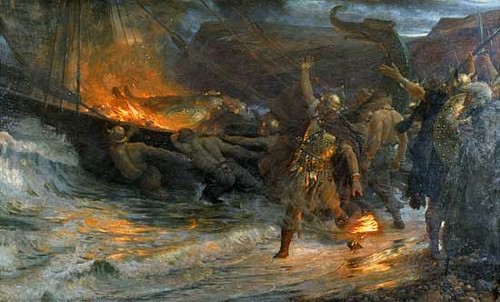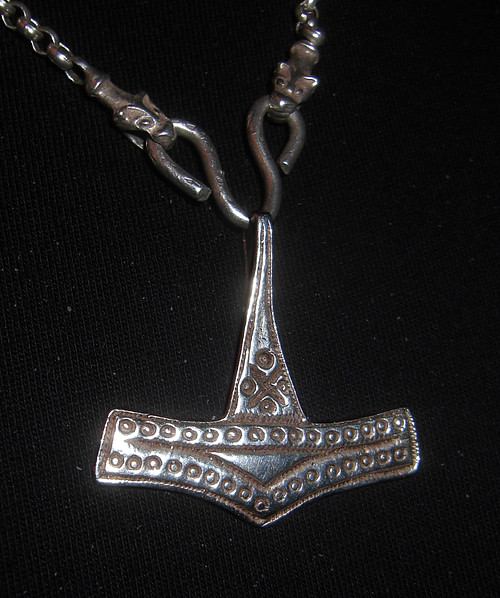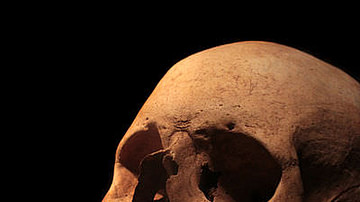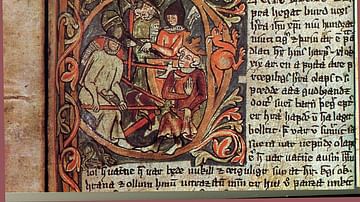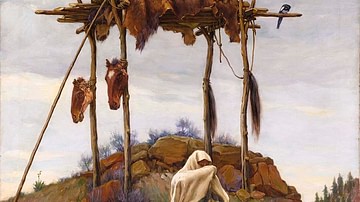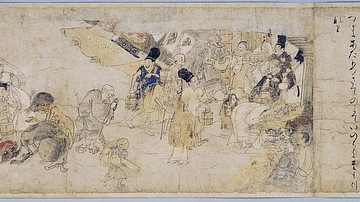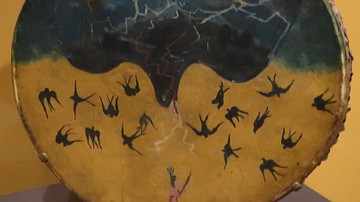In Norse belief, the soul of the deceased might wind up in any one of a number of afterlife realms. There was Valhalla, the realm of Odin where the dead warriors drank, fought, and told stories, Folkvangr ('the Field of the People'), the realm of the fertility goddess Freyja, and then there was Hel, where the majority of souls went, a grey and dismal place.
Whichever of these realms one finally went to was unknown to the living but one thing seemed sure: the departed could also return as a ghost. Ghosts were very real to Scandinavians before and during the Viking Age (c. 790-1100 CE), as they have been to many cultures throughout history and around the world. These ghosts, however, were not the ethereal spirits of the Classical World nor of the Anglo-Saxons, Franks, or Germanic tribes who were contemporaries of the medieval Norse, but reanimated corpses – often grown to immense size and strength after death – who could trouble, or even kill the living.
Anecdotal evidence for the Norse belief in ghosts comes from the great sagas written down mainly in roughly 13th-century CE Iceland; empirical evidence comes from the accounts of funerary rites people practiced to protect themselves from those who walked after death. Norse ghosts were of two types:
- The Haugbui – a soul who remained in his or her burial mound and guarded their grave goods.
- The Draugr, also known as an aptrgangr (“after-goer” or “again-goer”, “one who walks after death”) – a soul who emerged from the grave at night to trouble the surviving family or community. A draugr could be exceptionally tall, strong, was always hungry, and could shape-shift as well as control the weather and predict the future.
If one had trouble with a haugbui it was one's own fault for disturbing the grave. The haugbui was thought to be endlessly ravenous – as all the dead were – and would eat a person who entered the burial mound without just cause but, otherwise, they kept to themselves. A draugr, however, might trouble the living for any reason from simply being bad-tempered, to envy of the living, or the improper observation of funeral rites.
This last reason was considered most important; funerary rituals honored the dead and ensured their good memory and so, if they were not performed correctly, it showed a deep lack of respect for the departed. Naturally, the surviving members of the family did all they could to give their loved one a proper send-off. Even so, it was unclear exactly how the deceased might interpret these efforts and so other rituals were created to make sure that, even if the dead person was not resting in peace, the living would be able to.
Proper Burial
There were no funeral homes or undertakers in Viking Age Scandinavia, as in Europe as a whole at that time, and the deceased person's body was prepared for burial in the home by the family. It was, therefore, the family's responsibility to make sure that the body was well-cared for and buried properly. Scholar Martin J. Dougherty writes:
The Vikings believed that proper funeral rites were essential if the deceased soul were to move on to the afterlife. A suitable funeral ensured that the spirit did not remain to haunt the living and would have its rightful status in the next life. Grave goods were important to ensuring this status; archaeological studies of burial sites have contributed greatly to what we know about the Vikings and their way of life. (39)
Cremation was the preferred method of disposing of bodies in pre-Iron Age Scandinavia (c. 6th century BCE) although there is evidence of burial with grave goods. Burial became more commonplace during the Viking Age but cremation on a pyre (the famous image of the Viking funeral) was still practiced. Burying people in ships (such as the famous Oseberg Ship grave mound in Norway) seems to have been a luxury reserved for the wealthy since ships were so expensive. Even a wealthy family might not have buried a ship but would still have provided adequate grave goods.
Still, burial sites of seemingly well-off individuals have been excavated which show few grave goods. It is thought that, at times when a family was not doing so well financially, a particularly valuable lamp, weapon, or tool which could not easily be replaced, was kept back by the living (a hammer, for example, which a family could not afford to lose). Scholars come to this conclusion based on excavated graves of wealthy people which, they feel, should have had more objects placed in them. Even though keeping a certain object would be understandable to those who continued breathing and eating, it might not be so to the dead. Even if every other aspect of the burial was done perfectly, the spirit of the deceased might still take exception to being deprived of its favorite sword or hammer.
Further, seven days after a person's death, a funeral feast was held called the Sjaund (which, according to Dougherty, was also the name of the ale served at the feast) at which the affairs of the dead person were settled. Items of personal importance that had not gone into the grave were dispensed to family members or friends in accordance with the deceased's wishes or those of the immediate family. The Sjaund might appear to go off quite well to the living but one never could tell how it would be interpreted by the spirit of the deceased or how they might react if displeased.
Ghost Prevention
In order to protect themselves and their families from a haunting by an upset or envious spirit, Viking Age Scandinavians took precautions which included:
- Head wrapping
- Carrying the corpse out the door feet first
- Sewing together the toes of both feet or the feet together
- Breaking the legs or tying shoe- or bootlaces together
- The Corpse-Door
- Knocking three times when visiting a home
- The use of talismans and images
Head wrapping was simply wrapping the head of the corpse so the spirit could not see where it was going. Even though the eyes were closed, it was believed the dead person could still see. Carrying the corpse out the door feet first was done for the same reason: the spirit of the person would not be able to see where it was being taken for burial and so would not be able to find its way back home.
Since it was believed the dead could reanimate and walk, tying or sewing the feet or toes together was done so that, if the corpse did remember the way, it would have a harder time getting back home. Breaking the legs or ankles or tying the laces of the shoes or boots together was done for the same reason.
The most labor-intensive safeguard was the corpse-door: an opening built into a home which was then bricked up and, after a death, broken open to carry the corpse out. Since it was believed the reanimated dead could only enter a house through the same opening it had gone out, after the dead person was carried out feet first and brought to the cemetery, the corpse-door was sealed up again.
After darkness fell year-round, and especially so shortly after a funeral, it was common practice in Viking Age society to knock three times outside someone's home when visiting. A single knock was interpreted as the presence of a spirit and, if one opened the door, one either went insane or was never seen again. Ghosts were thought to become active in autumn and gain strength throughout winter and especially around Christmas. Knocking three times may also have been linked to the Christian trinity.
Talismans such as Odin's head, Thor's hammer, and, after the rise of Christianity (c. 10th-12th centuries CE), Christ's cross were also frequently used to ward off spirits as were images of the same carved on door posts or small wooden statues above or just inside the door. Pieces of straw or open scissors were laid on the dead person's chest in the form of a cross to give peace to the soul and prevent its return.
Bird images, representing Odin's ravens Huginn and Muninn ('thought' and 'memory'), were carved on tombs as a sign of respect and so was the image of Odin's knot (the valknut) which symbolized his power to bind and loose, related to his authority over life and death. The best way to placate the spirit of a dead family member or friend, however – in as much as possible – was fond remembrance.
Memory & the Afterlife
As in other cultures, a good name after death was considered most important. People were encouraged to live their lives well in consideration of family and community so that, after death, they would be remembered well and stories would continue to be told of them; these stories would keep them alive as long as they were told. Scholar Preben Meulengracht Sørensen writes:
Death is one of the facts of life that confronts us most clearly in the sources for the Viking Age. In the Old Norse literature, it is the goal of life in an entirely different way than in later Christian ideology. In pre-Christian times it was important to live in such a way as to have a good posthumous reputation. It was this that made the manner of death so important: nothing was worse than a shameful death…A good earthly reputation, not heavenly salvation, was the most profound aim of life and death. (Sawyer, 216)
The afterlife realm of Valhalla combined both of these values in that the hero who went to Odin's hall lived on there but was also remembered by those still living. Valhalla may not have been as important to earlier, pre-Viking Age, Norse as it was later after Scandinavians had encountered the Christian concept of heaven, though. Scholar Kristen Wolf, among others, has pointed out that the name Valhalla “is applied to certain rocks in southern Sweden that were believed to house the dead” and that this belief grew into the vision of “a magnificent palace in which dead kings and warriors gathered” after Scandinavians became acquainted with the Christian heaven (Wolf, 216).
The emphasis on a good name after death, linked with the importance of stories told of one's reputation and the eternal aspect of the Christian heaven, may have all gone toward later Nordic Christian scribes creating the image of Valhalla so ingrained in the Norse legacy in the present day. Wolf (and others) claim that Valhalla, and the concept of a glorious afterlife, was not a significant value in pre-Christian Scandinavia. With the rise of Christianity in Scandinavia in the 10th-12th centuries CE, this argument goes, more people began to concentrate on an afterlife than their present existence. The well-known stories of Viking warriors fearlessly facing death in battle are therefore more of a construct from a later, Christian, period and were not as integral a part of Norse belief during the Viking Age.
It is of course true that Christian scribes interpreted and edited Norse beliefs through their own lens but it is difficult to accept the claim that pre-Christian Norse gave little thought to an afterlife. There is ample evidence from skaldic poetry (Viking Age, pre-Christian poetry mainly heard at courts by kings and their retinues) to physical evidence of talismans, runes, and engravings that Vikings of the pre-Christian age had hope of a glorious afterlife which freed them from any fear of death. While they lived and raided other lands, they enjoyed themselves and, after death, they would continue to do so.
This view is expressed well in the last words of the legendary Viking leader Ragnar Lothbrok from the saga that bears his name. Although The Saga of Ragnar Lothbrok dates from the 13th century CE, the story is thought to be older and reflect pre-Christian values. Before he is executed by being thrown into the pit of snakes by King Ælla of Northumbria, Ragnar says:
It gladdens me to know that Balder's father [Odin] makes ready the benches for a banquet. Soon we shall be drinking ale from the curved horns. The champion who comes into Odin's dwelling does not lament his death. I shall not enter his hall with words of fear upon my lips. The Aesir will welcome me. Death comes without lamenting…Eager am I to depart! The Disir summon me home, those whom Odin sends for me from the halls of the Lord of Hosts. Gladly shall I drink ale in the high-seat with the Aesir. The days of my life are ended. I laugh as I die. (Davidson, 150)
Ragnar would be assured of a continued existence through the memory of the living and the tales they told of him; he would have left behind a good name and stories people would want to tell and hear. As far as his position in the realms after death, Ragnar's gratitude toward the Æsir (the principal pantheon of Norse gods) and the Dísir (female familiar spirits who watched over a family) in bringing him home would have guaranteed him a good place. More importantly, though, this belief allowed for a Viking warrior or Scandinavian weaver, cook, or brewer to face life without fear because one did not need to fear death; one would continue to exist – the only question was where one might end up.
Conclusion
In Norse belief, one's final destination had nothing to do with the judgment of the gods; the soul could wind up in an afterlife as stirring as Valhalla, peaceful as Folkvangr, dismal as Hel, or simply sitting in one's grave. There was nothing one could do to influence where one's soul would go because there was no judgment of the dead. Odin's Valkyries selected warriors for Valhalla for their own reasons, Freyja did the same for her realm, and how souls wound up in Hel was anyone's guess.
Death was viewed as a tragic event by the Norse in that one lost everything one loved to travel to another world one knew nothing of. Even so, there was nothing the living could do about this situation. The best one could do was simply live one's life to the fullest without fear and leave one's afterlife to the will of the gods. One might not get the afterlife one hoped for but there was at least a continued existence somewhere in some form.
For those who had to tend to the affairs of the departed, however, nothing was left to chance. It could happen that, once the soul reached the other side and found it wanting, they would forget about gratitude and come back to share their misery with those they had left behind. Funerary rites and rituals ensured that, even if the dead were upset with their afterlife or some aspect of the funeral, they would not be able to trouble the living about it.
